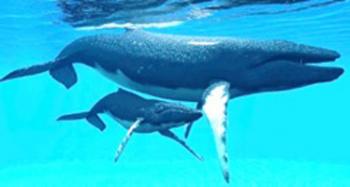Serendip is an independent site partnering with faculty at multiple colleges and universities around the world. Happy exploring!
How Whales Evolved – Evidence and Scientific Arguments

Students begin by comparing the characteristics of whales, mammals and fish to decide whether whales should be classified as mammals or fish. To support their conclusion, students make a scientific argument (claim, evidence, reasoning).
Students learn about the evolution of whales and other cetaceans by analyzing evidence from comparative anatomy, embryology, fossils, and DNA and proteins. Finally, students make a scientific argument for the claim that whales and other cetaceans evolved from land mammals.
The Student Handout is available in the first two attached files and as a Google doc designed for use in online instruction and distance learning. (For additional instructions, see https://serendipstudio.org/exchange/bioactivities/Googledocs, especially item 7.) The Teacher Notes, available in the last two attached files, provide instructional suggestions and background information and explain how this activity is aligned with the Next Generation Science Standards.
Students begin by comparing the characteristics of whales, mammals and fish to decide whether whales should be classified as mammals or fish. To support their conclusion, students make a scientific argument (claim, evidence, reasoning). Students learn about the evolution of whales and other cetaceans by analyzing evidence from comparative anatomy, embryology, fossils, and DNA and proteins. Finally, students make a scientific argument for the claim that whales and other cetaceans evolved from land mammals.
| Attachment | Size |
|---|---|
| evolution whales SH.docx | 2.59 MB |
| evolution whales SH.pdf | 588.99 KB |
| evolution whales TN.docx | 3.12 MB |
| evolution whales TN.pdf | 988.77 KB |











Comments
Post new comment